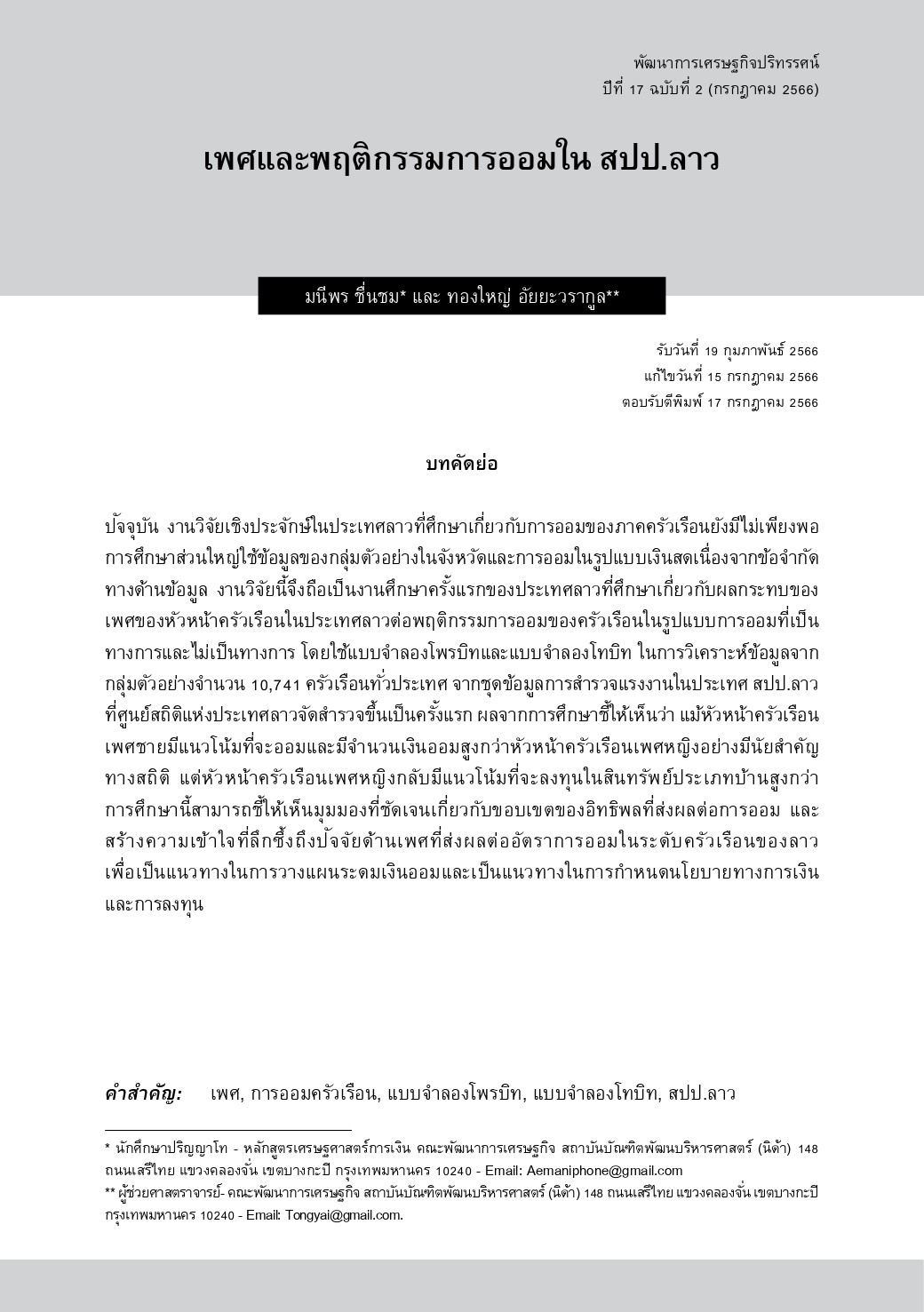Gender differences in saving behaviors, Lao PDR
Abstract
At present, there is insufficient empirical research in Laos on household savings. Most studies used a sample in the province and saving in cash due to the limitation of data. This is the first research in Laos that examines the role of gender of household head on household saving behaviors in both formal and informal savings. We analyze data from a sample of 10,741 households from Lao PDR Labor Force Survey 2010, the first survey in Lao PDR conducted by the National Statistical Office of Laos, using Probit and Tobit model and find that while male household heads have a statistically higher propensity to save and a statistically higher amount savings, female household heads tend to invest more in durable household assets. These findings demonstrate the importance of understanding gender relations at the household level in planning for savings mobilization and in the formulation of financial and investment policies.
References
Abdelkhalek, T., Arestoff, F., Freitas N., and Mage, S. (2010). A MICROECONOMETRIC
ANALYSIS OF HOUSEHOLD SAVINGS DETERMINANTS IN MOROCCO. African Review of Money Finance and Banking , 2010, (2010), pp. 7-27.
Ahmad, M., & Asghar, T. (2004). Estimation of Saving Behaviour in Pakistan Using Micro Data. Lahore Journal of Economics, 9(2).
Alemu, B. (2021). Determinant Of Saving Performance Of Women Headed Households In Bahirdar City. International Journal of Academic Multidisciplinary Research (IJAMR) ISSN: 2643-9670 Vol. 5 Issue 2, February - 2021, Pages: 207-245.
Bui, T. (2000). Household saving behaviour in developing countries: the case of Vietnam. A dissertation submitted for the degree of Doctor of Philosophy of the Australian National University June, 2000.
Doss, Cheryl. (1996). “Women’s Bargaining Power in Household Economic Decisions:
Evidence from Ghana,” Department of Applied Economics Staff Paper P96-11,
University of Minnesota, July.
Fisher, P. (2010). Gender Differences in Personal Saving Behaviors (Vol. 21).
Gugerty, May Kay (1999). “Preliminary Evidence on Rotating Savings and Credit
Associations (ROSCAs) in Kenya: You Can’t Save Alone,” Mimeo, Harvard University
Gujarati, D.N. (2004). Basic Econometrics (4 th ed.). New York: McGraw Hill.
Howe, L., J.R. Hargreaves, and S. RA. Huttty. (2008). Issue in the construction of wealth indices
for the measurement of socio-economic position in low-income countries. Emerging Themes in Epidemiology 5(3).
Keynes, J. M. (1936). The general theory of employment, interest and money. London:
MacMillan.
Lao Statistics Bureau. (2009).Lao expenditure and consumption survey LECS4 Retrieved from Vientine:
Lao Statistics Bureau. (2010). Labour Force and Using Child Labour Survey 2010.
Lundberg, S.J., R.A. Pollak, and T.J. Wales, "Do husbands and wives pool their
resources?Evidence from the U.K. child benefit," Mimeo (Seattle, WA: University
of Washington, April1995).
McFadden, D. (1973). Conditional Logit Analysis of Qualitative Choice Behavior. In P.
Zarembka (Ed.), Frontiers in Econometrics (pp. 105-142). Wiley, New York: Academic Press.
Nadeem, M. (2020). Household Savings behavior in Rural and Urban Areas in Punjab,
Pakistan. xIlkogretim Online - Elementary Education Online,2020; Vol19(Issue 4):
pp.5718-5727.http://ilkogretim-online.org
Njung’e, P. (2013). GENDER AND HOUSEHOLD SAVINGS BEHAVIOR IN KENYA
PENNINAH Research paper submitted in partial fulfillment of the requirements for
the Degree of Master of Arts in Economics of the University of Nairobi November, 2013
Pootrakool, K., Ariyapruchya, K., and Sodsrichai, T. (2005). Long- termSaving in Thailand:
Are we saving enough and what are the risk. Bank of Thailand Economic Symposium 2005. 17-18 August 2005, at ESCAP Hall, United NationsConference Centre,Bangkok.https://www.bot.or.th/Thai/MonetaryPolicy/ArticleAndResearch/SymposiumDocument /paper5_2548.pdf.
Rehman, H. U., Faridi, M. Z., & Bashir, F. (2010). Households Saving Behaviour in Pakistan:
A Case of Multan District. Pakistan Journal of Social Sciences (PJSS),30(1),17-29.
Sannassee, Raja (2013). Demographic Transition and Savings Behavior in Mauritius.
January 2013, University of Mauritius. DOI:10.1016/B978-0-12-411549-1.00006-5
Seguino, Stephanie and Maria S. Floro (2003), “Does Gender Have Any Effect on
Aggregate Savings? An Empirical Analysis,” International Review of Applied Economics, 17(2): 147-166
Smith, Roger (1990). “Factors Affecting Saving, Policy Tools, and Tax Reform: A
Review,”IMF Staff Papers 37 (1): 1-70.
Souksavanh, K. (2013). The Impact of Household Saving onDevelopment of Rural
Livelihoods: Evidence from Luang Prabang, Northern Laos. PAPER NO. 10 / 2013
Mekong Institute Research Working Paper Series 2013
Suwanrada and Manprasert (2009) The Determinants of Private Savings Behavior in
Thailand: A Study from Micro-Data Field Surveys.
http://pioneer.netserv.chula.ac.th/~msompraw/Savings_NCE2009.pdf
Tadele Mengesha (2015).Household saving Performance in Jimma Zone of Oromia
Region, Jimma University Ethiopia, Journal Economics and Sustainable Vol.4,
No.3, 2013
Tobin, J. (1958). Estimation of Relationships for Limited Dependent Variables.
Econometrica, 26, 24-36.
Vansuriya, A., and Hengpatana, S. (2019). Thai Household Savings Ability Comparing between Formal and Informal Workers.Journal of Economics and Management Strategy Vol. 6, No. 2, July – December 2019

Downloads
Published
Issue
Section
License
Copyright to published manuscripts becomes the property of the Graduate School of Development Economics, National Institute of Development Administration. Reproduction of all or part of a Development Economic Review (DER) article by anyone, excluding author(s), is prohibited, unless receiving our permission.
Disclaimer: Opinions expressed in articles published in this journal are those of the author (s) and do nto necessarily represent opinions of the Graduate School of Development Economics, National Institute of Development Administration. Trade and proprietary names are only for identification and not constitute our endorsement.

